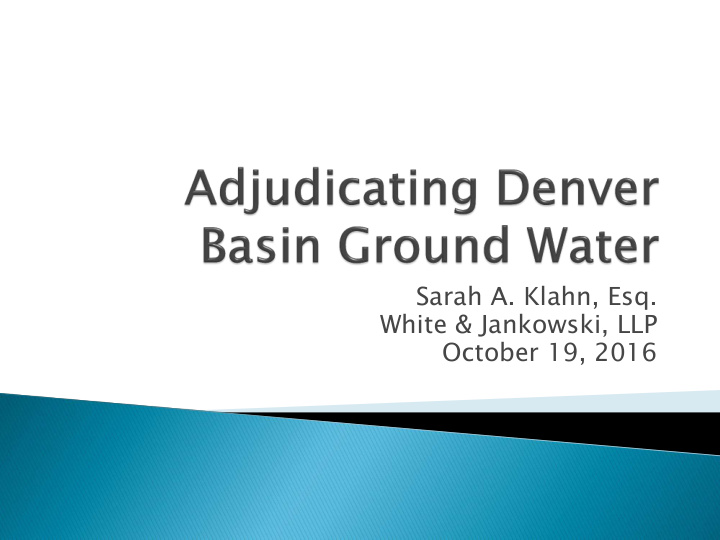



Sarah A. Klahn, Esq. White & Jankowski, LLP October 19, 2016
Organizing principles Overview of physical resource Overview of legal entitlement to Denver Basin ground water Overview of adjudication procedures and tools Is adjudication right for you? Questions
I am here to provide an overview of the adjudication process. Not here to form an attorney-client relationship! If you have specific legal questions about your situation, you should contact a qualified attorney.
Unlike tributary surface and ground water, Denver Basin ground water is distributed based on statutory provisions that entitle the overlying landowner to the divert (or pump) the water consistent with various rules. ◦ This does not mean you can pump as much as you want! Presentation tries to highlight the differences between: ◦ Legally ally available Denver Basin ground water ◦ Physic sically ally available Denver Basin ground water ◦ Econo nomical mically ly available Denver Basin ground water
Aquifer names: ◦ Dawson Lower Dawson Upper Dawson ◦ Denver ◦ Arapahoe ◦ Laramie-Fox Hills Non-tributary Not non-tributary (typically shallower aquifers but depends on location) Tributary (with some exceptions, all ground water that is not Denver Basin)
What and where is Denver Basin ground water physically available? And where is it economically available?
Framework for “legal availability”
Under Colorado statute 37-90-137(4), adopted in 1973: ◦ The right to withdraw non-tributary ground water resides with the owner of the land overlying the aquifer. ◦ The amount of non-tributary ground water that can be withdrawn by the landowner is limited to the total amount under the landowner’s property, at a rate no greater than 1% per year of that total amount.
To facilitate development of south suburban areas including Douglas County, the General Assembly authorized “mining” of Denver Basin aquifers All Denver Basin wells, whether adjudicated or not, are authorized to pump a volume of water based on an assumed 100 year life of the well This is the maximum legally available — whether the water is physically available, or, if physically available, it can be economically extracted are separate issues
Division of Water Resources (SEO) uses a ground water model to predict yields from various parts of the Denver Basin Whether applying for a permit OR to adjudicate Denver Basin ground water, DWR uses the ground water model to estimate the volume available beneath the legal description of your property
Enhances, but is not essential, to evaluating legal availability
Step 3: Statements of Opposition ◦ Must be filed by the last day of the calendar month following publication in the resume. ◦ Make the objector a party to the case for purposes of protecting interests. ◦ Does require either investment of time or money (or both).
File application Statements of opposition are filed — typically few filed if the water is Denver Basin nontributary Division Engineer issues summary of consultation which makes initial determinations of facts regarding the claims Applicant must address DEO issues in proposed decree Submit proposed decree
If pro se, Referee at the Water Court will work with applicant to refine decree If significant opposition, case may be referred immediately to the Water Judge
Go back to our three organizing principles: legal, physical and/or economically available? Goals of adjudicating? ◦ Value add for your property? ◦ Protect legal availability? ◦ Protect physical availability? Costs ◦ Money ◦ Time ◦ Anxiety Three possible scenarios: ◦ Property without existing well; Property with existing well; interest in subdividing or selling Property
The right to divert Denver Basin ground water arises from overlying land ownership. That right can be exercised by obtaining a well permit and drilling a well It can also be exercised by first going to Water Court, obtaining a decree authorizing the drilling of a well, and then obtaining a well permit and drilling the well. Note that Water Court rt adjudic icati ation on is not require red d to divert t non-tri tributa butary ry Denver Basin n ground nd wa water, , although ugh it ma may be required ed to divert t not non-tr tribu ibutar tary y Denver r Basin n ground nd water. .
The well permit reflects the amounts you are entitled to pump. Wa Water r Court rt adju judic dication ation is not requ quired ired to operate rate an existing, ing, perm rmit itted ted Denv nver er Ba Basin in we well. If your well is in a not non-tributary aquifer (such as the Upper Dawson Aquifer), it may only be operated if you have obtained an augmentation from in a Water Court adjudication.
If the property has an existing, permitted well, no adjudication is necessary. If the property has no existing wells and you are going through a subdivision process, you may be required to quantify the available Denver Basin ground water beneath the subject property. This can be done with the assistance of the Division of Water Resources.
Recommend
More recommend